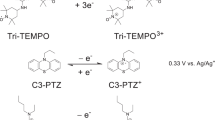Abstract
The kinetics of electrode reaction was investigated by cyclic voltammetry, and cyclic voltammograms show that the reversibility of the Fe(bpy)32+/Fe(bpy)33+ electrode reaction is better than that of the Zn/Zn2+ electrode reaction on the graphite disc. However, the Fe(bpy)32+ ion diffusion in electrolyte is subject to greater resistance than that of the Zn2+ ion one. The stability of the Fe(bpy)3Cl2 solution was investigated by UV-vis spectroscopy, and the performance of a mild redox flow battery employing ZnCl2 and Fe(bpy)3Cl2 in the NaCl aqueous solution with various membranes as the separator was also investigated. It was found that the Celgard 3501 membrane cannot effectively prevent Fe(bpy)32+ ions from leaking into anolyte, leading to the rapid failure of the flow battery. Although the Nafion 115 membrane can be polluted by Fe(bpy)32+ ions, it is not invalidated. The Nafion 115 membrane shows good selectivity, which can avoid Fe(bpy)32+ ions from leakage into anolyte. The ZnCl2/Fe(bpy)3Cl2 flow battery with the Nafion 115 membrane exhibits the capacity retention of 80% after 200 cycles.
Similar content being viewed by others
References
Shi Y, Peng L, Ding Y, et al. Nanostructured conductive polymers for advanced energy storage. Chemical Society Reviews, 2015, 44(19): 6684–6696
Li Z, Wang W, Liao S, et al. Integrating a redox flow battery into a Z-scheme water splitting system for enhancing the solar energy conversion efficiency. Energy & Environmental Science, 2019, 12(2): 631–639
Nguyen K H, Kakinaka M. Renewable energy consumption, carbon emissions, and development stages: Some evidence from panel cointegration analysis. Renewable Energy, 2019, 132: 1049–1057
Guney M S, Tepe Y. Classification and assessment of energy storage systems. Renewable & Sustainable Energy Reviews, 2017, 75: 1187–1197
Arani A K, Karami H, Gharehpetian G B, et al. Review of flywheel energy storage systems structures and applications in power systems and microgrids. Renewable & Sustainable Energy Reviews, 2017, 69: 9–18
Park M, Ryu J, Wang W, et al. Material design and engineering of next-generation flow-battery technologies. Nature Reviews Materials, 2017, 2(1): 16080
Shi Y, Eze C, Xiong B, et al. Recent development of membrane for vanadium redox flow battery applications: A review. Applied Energy, 2019, 238: 202–224
Wu M C, Zhao T S, Jiang H R, et al. High-performance zinc bromine flow battery via improved design of electrolyte and electrode. Journal of Power Sources, 2017, 355: 62–68
Xiang H X, Tan A D, Piao J H, et al. Efficient nitrogen-doped carbon for zinc-bromine flow battery. Small, 2019, 15(24): 1901848
Amini K, Pritzker M D. Improvement of zinc-cerium redox flow batteries using mixed methanesulfonate-chloride negative electrolyte. Applied Energy, 2019, 255: 113894
Xie Z, Yang B, Yang L, et al. Addition of graphene oxide into graphite toward effective positive electrode for advanced zinc-cerium redox flow battery. Journal of Solid State Electrochemistry, 2015, 19(11): 3339–3345
Tang C, Zhou D. Methanesulfonic acid solution as supporting electrolyte for zinc-vanadium redox battery. Electrochimica Acta, 2012, 65: 179–184
Liu J, Wang Y. Preliminary study of high energy density Zn/Ni flow batteries. Journal of Power Sources, 2015, 294: 574–579
Xiao M, Wang Y, Yao S, et al. Analysis of internal reaction and mass transfer of zinc-nickel single flow battery. Journal of Renewable and Sustainable Energy, 2016, 8(6): 064102
Gong K, Ma X, Conforti K M, et al. A zinc-iron redox-flow battery under $100 per kW h of system capital cost. Energy & Environmental Science, 2015, 8(10): 2941–2945
Luo J, Sam A, Hu B, et al. Unraveling pH dependent cycling stability of ferricyanide/ferrocyanide in redox flow batteries. Nano Energy, 2017, 42: 215–221
Arroyo-Currás N, Hall J, Dick J, et al. An alkaline flow battery based on the coordination chemistry of iron and cobalt. Journal of the Electrochemical Society, 2015, 162(3): A378–A383
Wen Y, Zhang H, Qian P, et al. A study of the Fe(III)/Fe(II)-triethanolamine complex redox couple for redox flow battery application. Electrochimica Acta, 2006, 51(18): 3769–3775
Wen Y, Zhang H, Qian P, et al. Studies on iron (Fe3+/Fe2+)-complex/bromine (Br2/Br−) redox flow cell in sodium acetate solution. Journal of the Electrochemical Society, 2006, 153(5): A929–A934
Chen Y, Santhanam K, Bard A. Solution redox couples for electrochemical energy-storage. I. Iron(iii)-iron(ii) complexes with O-phenanthroline and related ligands. Journal of the Electrochemical Society, 1981, 128(7): 1460–1467
Murthy A, Srivastava T. Fe(III)/Fe(II)-ligand systems for use as negative half-cells in redox-flow cells. Journal of Power Sources, 1989, 27(2): 119–126
Walsh F, Ponce de Léon C, Berlouis L, et al. The development of Zn-Ce hybrid redox flow batteries for energy storage and their continuing challenges. ChemPlusChem, 2015, 80(2): 288–311
Park M, Beh E S, Fell E M, et al. A high voltage aqueous zinc-organic hybrid flow battery. Advanced Energy Materials, 2019, 9(25): 1900694
Acknowledgements
This work was financially supported by the National Natural Science Foundation of China (Grant No. 21361010), the Natural Science Foundation of Jiangxi Province (20171BAB206001), the Education Department of Jiangxi Province (GJJ190433), the China Scholarship Council (201708360025), as well as the Hundred-men Voyage Project.
Author information
Authors and Affiliations
Corresponding authors
Rights and permissions
About this article
Cite this article
Xie, Z., Wei, L. & Zhong, S. An aqueous ZnCl2/Fe(bpy)3Cl2 flow battery with mild electrolyte. Front. Mater. Sci. 14, 442–449 (2020). https://doi.org/10.1007/s11706-020-0523-7
Received:
Accepted:
Published:
Issue Date:
DOI: https://doi.org/10.1007/s11706-020-0523-7



